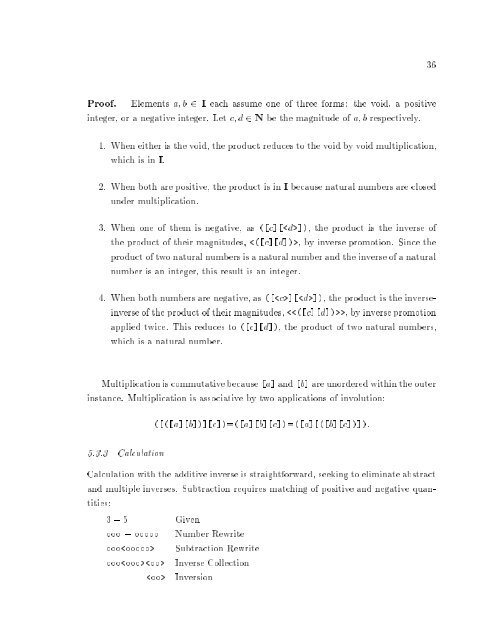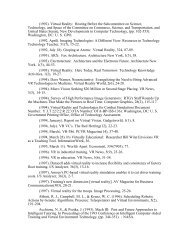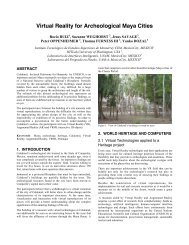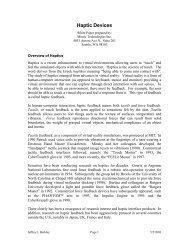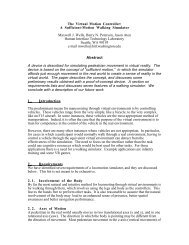A Calculus of Number Based on Spatial Forms - University of ...
A Calculus of Number Based on Spatial Forms - University of ...
A Calculus of Number Based on Spatial Forms - University of ...
You also want an ePaper? Increase the reach of your titles
YUMPU automatically turns print PDFs into web optimized ePapers that Google loves.
36<br />
Pro<str<strong>on</strong>g>of</str<strong>on</strong>g>.<br />
Elements a; b 2 I each assume <strong>on</strong>e <str<strong>on</strong>g>of</str<strong>on</strong>g> three forms: the void, a positive<br />
integer, or a negative integer. Let c; d 2 N be the magnitude <str<strong>on</strong>g>of</str<strong>on</strong>g> a; b respectively.<br />
1. When either is the void, the product reduces to the void by void multiplicati<strong>on</strong>,<br />
which isinI.<br />
2. When both are positive, the product is in I because natural numbers are closed<br />
under multiplicati<strong>on</strong>.<br />
3. When <strong>on</strong>e <str<strong>on</strong>g>of</str<strong>on</strong>g> them is negative, as ([c][]); the product is the inverse <str<strong>on</strong>g>of</str<strong>on</strong>g><br />
the product <str<strong>on</strong>g>of</str<strong>on</strong>g> their magnitudes, ; by inverse promoti<strong>on</strong>. Since the<br />
product <str<strong>on</strong>g>of</str<strong>on</strong>g> two natural numbers is a natural number and the inverse <str<strong>on</strong>g>of</str<strong>on</strong>g> a natural<br />
number is an integer, this result is an integer.<br />
4. When both numbers are negative, as ([][]); the product is the inverseinverse<br />
<str<strong>on</strong>g>of</str<strong>on</strong>g> the product <str<strong>on</strong>g>of</str<strong>on</strong>g> their magnitudes, ; by inverse promoti<strong>on</strong><br />
applied twice. This reduces to ([c][d]); the product <str<strong>on</strong>g>of</str<strong>on</strong>g> two natural numbers,<br />
which is a natural number.<br />
Multiplicati<strong>on</strong> is commutative because [a] and [b] are unordered within the outer<br />
instance. Multiplicati<strong>on</strong> is associative bytwo applicati<strong>on</strong>s <str<strong>on</strong>g>of</str<strong>on</strong>g> involuti<strong>on</strong>:<br />
([([a][b])][c])=([a][b][c])=([a][([b][c])]):<br />
5.3.3 Calculati<strong>on</strong><br />
Calculati<strong>on</strong> with the additiveinverse is straightforward, seeking to eliminate abstract<br />
and multiple inverses. Subtracti<strong>on</strong> requires matching <str<strong>on</strong>g>of</str<strong>on</strong>g> positive and negative quantities:<br />
3 , 5 Given<br />
, <str<strong>on</strong>g>Number</str<strong>on</strong>g> Rewrite<br />
Subtracti<strong>on</strong> Rewrite<br />
Inverse Collecti<strong>on</strong><br />
Inversi<strong>on</strong>


